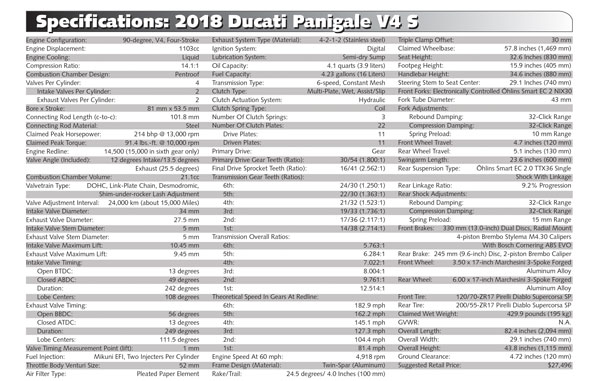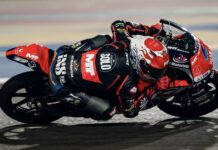Editorial Note: This article was originally published in the March 2018 print issue of Roadracing World & Motorcycle Technology.
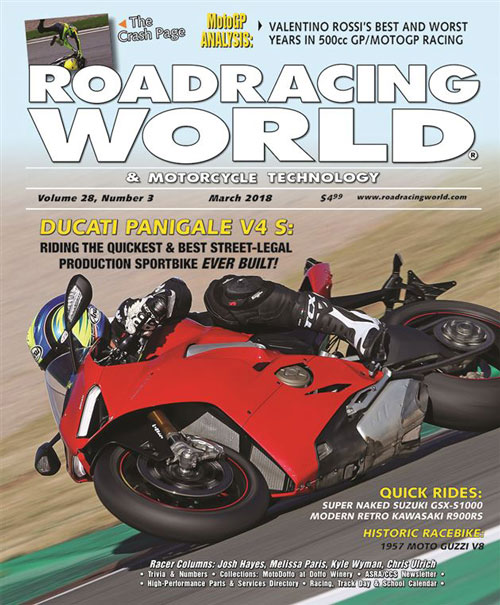
2018 Sportbike Intro: Ducati Panigale V4 S
Dawn Of The New Ultra-Performance Era
By Chris Ulrich
I could see a rider off in
the distance as I took the checkered flag at the end of my first racetrack
session of the day on the newest Ducati sportbike. Not wanting to give away
valuable testing time by touring, I stayed on the gas, pushing hard through
Valencia’s
fast third-gear left-hand Turn One, which is taken at well over 150 kph (over
90 mph). It’s
a daunting piece of racetrack that was forever etched into MotoGP history when
Marc Marquez famously saved his 2017 World Championship title there, losing the
front but keeping the bike upright on his knee!
Exiting the turn, I kept
pushing in the run to Turn Two, a relatively slow, second-gear corner. I got on
the brakes late, still careful to not rush the entry, rotated the Panigale V4 S
and fired it out with the DTC (Ducati Traction Control) and DWC (Ducati Wheelie
Control) indicators lighting up the dash.
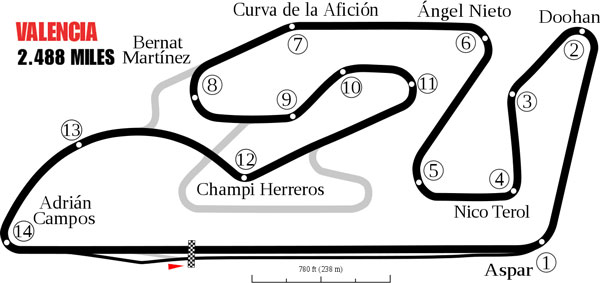
I drew closer to the rider
ahead, and could see that he was slender and wearing slightly baggy leathers,
and reminded myself to stay on task. The V4 and I railed through the fast,
left-hand Turn Three and then headed toward the first right-hand turn on the
Valencia road course, Turn Four. I knew the tires were hot, but the ambient
temperature was cool, so I was a little careful on turn-in but was back on full
gas exiting and driving into Turn Five—another right-hand turn taken in second
gear—trailing off the brakes, the ABS barely kicking in. Hitting a late apex, I
clipped the inside curb late and opened the gas as the rear tire of the
Panigale dug in, the carcass flexing and the tire spinning slightly as the DTC
kicked in and helped the Pirelli Supercorsa SP regain enough traction to
flatten the contact patch and drive the bike forward, setting off a slight
wallow as I headed to Turn Six.
I lit the rear tire up and
ripped through the gears as I headed out of Turn Six and through the
back-straight kick, which doubles as Turn Seven, and slammed on the brakes for
Turn Eight. The rider ahead of me was larger, and I could make out the colors
of a Ducati Factory suit with the numbers 00 emblazoned on the center of the
back—and he wasn’t touring, either. The fun of making a pass never gets old; you can take
the racer out of the race, but you can’t take the race out of the racer. Through the
Turn Nine left-hand kink now, then back to the right for Turn 10 and into Turn
11, a 180-degree right. I trailed the brakes out to three-quarter track width,
then released them and rolled through the middle of the corner before
tightening my line; the Panigale V4 turned down nicely, allowing me to clip the
inside curb and open up the exit for maximum drive, and now I had just a few
more meters to close before I was within a safe striking distance for making a
pass.
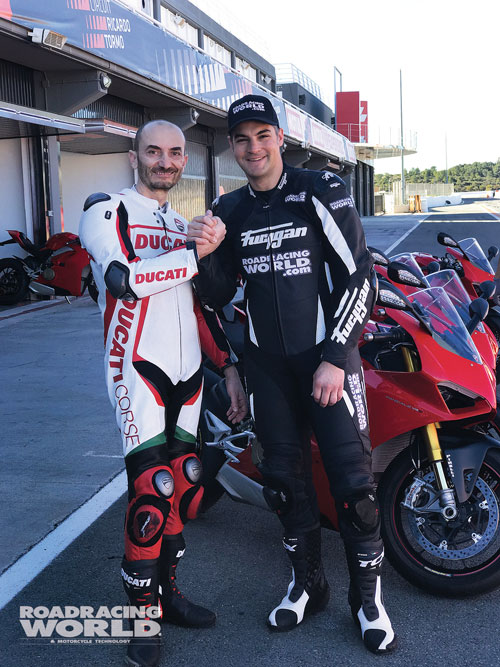
(Above) Chris Ulrich (right) with Ducati CEO Claudio Domenicali (left) on pit lane at Valencia.
I closed up more as I
braked late for Turn 12, a short, right-hand flick. Then I whipped the bike
from right to left and slammed it on my knee, pulling the throttle back to the
stop and flying around the outside of the rider I had been chasing. The rear
tire protested and I was well into the DTC followed by the DSC (Ducati Slide
Control) with the rear tire searching for grip. I stayed on the gas as I
crested a hill and spotted the final turn, before rolling off, signaling and
putting on the brakes. As we headed into pit lane, I realized the rider I’d chased down and gone by
well closer than necessary was Ducati CEO Claudio Domenicali. Thankfully it was
all smiles when we took our helmets off on pit lane.
***
When the motorcycle
industry is struggling to find its way and reach new riders, it is impressive
to see the CEO of Ducati going fast on the racetrack and enjoying the
motorcycles the iconic company sells. Domenicali is a CEO who is more in touch
with the passion of motorcycling than most top executives in the motorcycle
business, saying, “We have to always remember what we are existing for, as a brand, as a
company, as a group of people. It’s very, very important to come back to reality,
and remember what two-wheel emotion is about.”
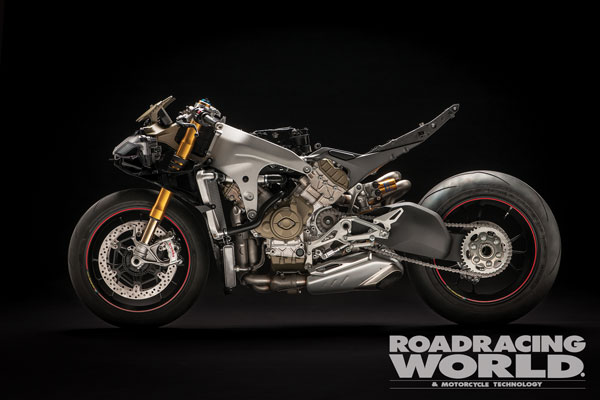
(Above) The Ducati Panigale V4 S without bodywork, showing the cast aluminum-alloy main frame and magnesium sub-frame, which both bolt to the engine.
That two-wheel emotion at
Valencia was about a MotoGP-derived V4 production street motorcycle with a
claimed 214 horsepower that happily does power-slides and power-wheelies, and
marks a new era for Ducati. The Italian company has built a streetbike that put
an ear-to-ear grin on the face of every member of the very seasoned group of
motojournalists gathered at Valencia for the official worldwide press intro.
The V4 era at Ducati is all about big passion, combined with big
performance. And that passion starts at
the top with Mr. Domenicali.
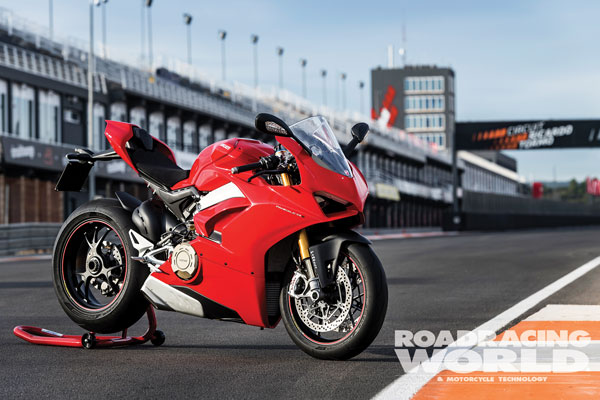
(Above) The Ducati Panigale V4 S with bodywork, posing at the racetrack.
Being in touch with the
emotions and sensations generated by motorcycling could explain why Ducati’s worldwide sales have
continued to grow. Granted, the brand’s U.S. sales grew just a little over 1%, but
hey, it’s
growth at a time when some companies are dealing with declining or flat sales.
In my opinion, Ducati’s corporate passion is a big part of the company’s success, along with a willingness to
continually build cutting-edge machinery without compromise. In regard to the
Panigale V4, Ducati abandoned the engine configuration that made the brand and
moved on without fear of the next challenge. And Ducati engineers then
designed, developed and built the fastest and most advanced street motorcycle
that has come to market this decade. And the company as a whole is unapologetic
about the big decision to build a four-cylinder flagship. That being said, fans
of V-Twins shouldn’t worry—Ducati will keep using the V-Twin configuration for models below
1000cc.
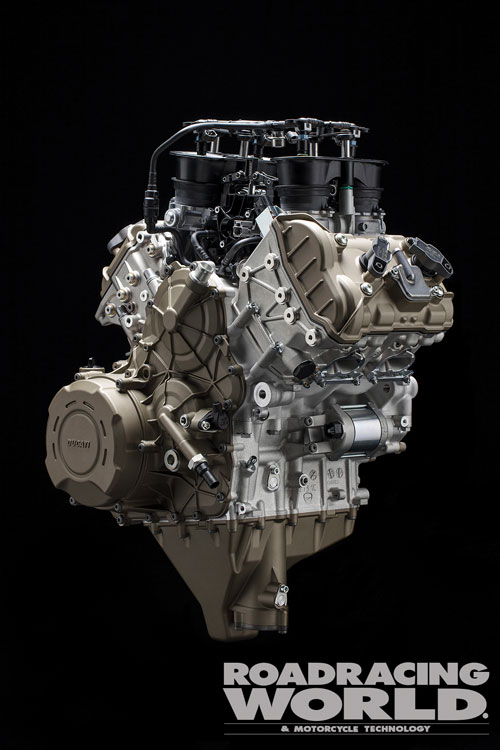
(Above) The Desmosedici Stradale V4 engine with Mikuni fuel injection throttle bodies in place.
Still, some die-hard
Ducatisti may say the latest Panigale and its Desmosedici Stradale V4 engine is
not a representation of Ducati and disrespects the brand’s V-Twin heritage, and that it’s heresy for Ducati to
build anything other than a street-legal, V-Twin four-stroke sportbike. But
Ducati’s
roots are in racing and building high-performance motorcycles that can win road
races at the highest level of competition. The Panigale V4 may be a new
direction, but it does not abandon Ducati’s roots, it embodies the company’s tradition of building
technologically advanced, high-performance motorcycles. Make no mistake: The
2018 Ducati Panigale V4 is all about performance. It is also packed with
technology, and is a fitting machine to lead Ducati’s line of performance-oriented sportbikes well
into the future.
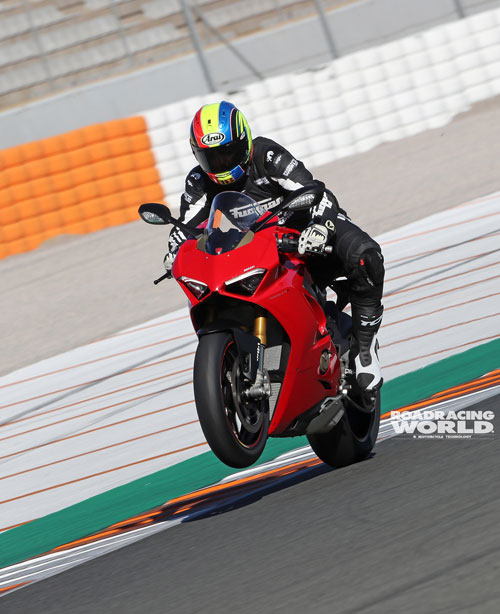
(Above) The Ducati Panigale V4 S has the best electronics available on a production sportbike sold to the public, including adjustable Ducati Traction Control (DTC), Ducati Wheelie Control (DWC) and Ducati Slide Control (DSC).
Let’s
face it, the Panigale 1299 and the preceding over-1000cc V-Twin Panigale models
could be very difficult to ride around a racetrack at speed. They demanded a
high level of skill, absolute concentration, and top-notch fitness to push
anywhere near the limits of the bike. The big V-Twin Panigales could also be
hard to understand, which made setting the bike up to be competitive at
different racetracks more complicated than it was with other bikes. The
demanding nature of the V-Twin Panigale showed in its results on the racetrack:
It took Ducati two seasons to win its first Superbike World Championship race
with the Panigale 1199 R and the bike never produced the type of consistent
racing success enjoyed with the steel-tube trellis-framed 851, 888, 916, 999,
and 1098-based Superbikes. (We could also list assorted subsets and
developments of those original models, but it would be moot. You get the point…)
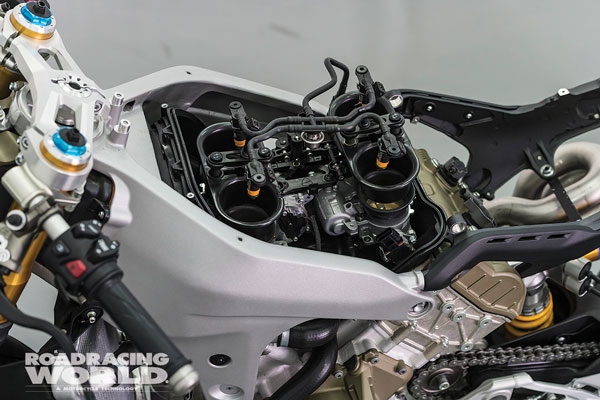
(Above) View from above the cast aluminum-alloy main frame and magnesium subframe bolted to the engine, and the double-barrel throttle bodies with variable length velocity stacks mounted above and between the cylinder banks.
This could be due to the
1199 R’s
monocoque chassis design or the extreme dimensions of the Supersquadro V-Twin
engine or a combination of both. Imagine the gyroscopic effect set off by the 1199 R’s two-massive 112 mm pistons (116 mm for the
1299 R, which is too big for World Superbike rules), located relatively high in
the chassis, banging around inside the engine and spinning the crankshaft at
very high rpm. The bottom line is that the racebike was a beast and Ducati
needed a big change to tame it.
Solidifying the decision was the fact that
Ducati engineers realized they would have to go to beyond 1299cc (the
displacement of the latest Panigale 1299 R streetbike) to make the Panigale the
most powerful production sportbike on the market. So they took the next logical
step, building a V4 powered sportbike using technology from Ducati’s title-contending
MotoGP program.
***
Ducati could have played it
safe for the international press introduction of the Panigale V4 S and gone to
a more forgiving track than the Ricardo Tormo Circuit in Valencia, Spain. The
track is relatively tight with only one real straightaway to rest on, which makes
it pretty physically demanding even if you are race-fit. That means it’s a total ball-buster if
you are a desk-bound journalist, but I’ll leave the subject of my non-racing fitness
level for a column! Ducati marketeers and engineers wanted a track where the
Panigale V4 could show off its handling prowess while highlighting the
strengths of both the engine and the electronics package, proving the new
flagship model to be the total package. So they chose Valencia as the ideal
location to do it.
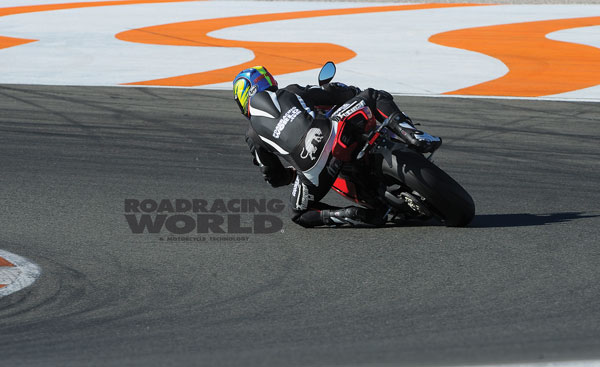
(Above) Chris Ulrich gets ready to square-up a corner at Valencia on the 2018 Ducati Panigale V4 S. The Ducati Slide Control (DSC) system allows the rider to drift the rear wheel to rotate the bike mid-corner.
In terms of ergonomics, the
Panigale V4 S feels very similar to its V-Twin predecessors. The seat position
is aggressive, the reach to the handlebars long, the fuel tank narrow, and the
footpegs high—10 mm higher than the pegs on the 1299 R. Thanks to an uneven
firing order, the V4 sounds slightly like a V-Twin while idling. In fact, the
power delivery feels slightly like a V-Twin out on the racetrack, too.
The Panigale V4 S didn’t disappoint at all on
the racetrack, even during the first orientation session when the electronics
were set in the less-aggressive Sport Mode, which slightly softens the throttle
map and the power delivery. At the start of the intro, the rider aid settings
were also turned up with DTC on 5, DWC on 4, DSC on 2 and ABS on 2. Even with
the softer throttle map and the rider aids turned up, the Stradale engine was
impressive from the first exit of pit lane. And the electronics intervened very
smoothly. It felt like power reduction is handled by reducing the rate at which
the throttle plates open, depending on the mode selected and the lean angle;
the abrupt power cuts experienced on the big Panigale V-Twin models are gone.
My first impression of the
chassis was also positive. It isn’t overly stiff, and the Panigale V4 turned in
well, rotated well at the apex, then finished the turn without pushing wide.
And it was much easier to close my line in Valencia’s long, 180-degree turns like right-hand Turn
11. I could carry good speed at corner entry, which forced the bike to the
middle of the track, then rotate around
at three-quarters of the way through the turn and get back down to the inside
curb, which put me in position for a great drive at the corner exit. I would
have been plowing the front tire and cursing if I had tried to do that at the
same entry speed on the old bike. The new, more balanced handling
characteristics are helped by the counter-rotating crankshaft, which helps
reduce the gyroscopic forces created by the wheels. In my first 10 minutes of
riding the Panigale V4 S, I could already tell that the Ducati engineers had
done something special.
Once that first orientation
session was over, technicians set the electronics in Race Mode for the
remainder of the sessions. That change delivered more direct throttle
opening—it feels like it’s 1:1—and
unleashed the full power of the Desmosedici Stradale engine. The techs also
dialed-in slightly more aggressive rider aid settings of DTC 3 and ABS 1. I
took it a step further as the day went on, turning the rider aids down in each
session before finally landing on DTC 1, DWC 2, DSC 1, and ABS 1.
In Race Mode, power starts
to build from around 7,500 rpm and the bike continues to pull hard until around
13,500 rpm. The Ducati feels like it really takes off as the revs climb over
11,000 on the straight, and I suspect this is a by-product of the constantly
adjusting variable-length intake track going from long to short funnels.
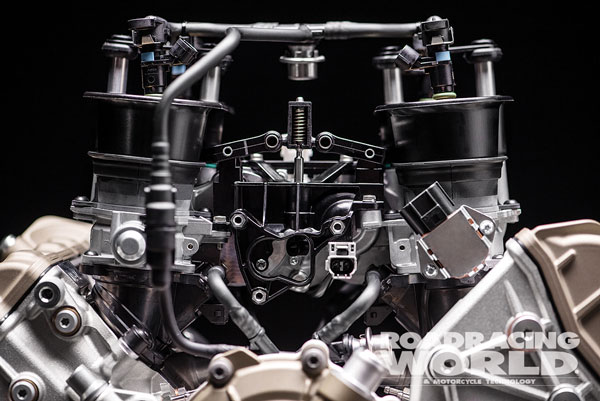
(Above) The double-barrel Mikuni 52mm throttle bodies are seen here with the variable-length velocity stacks in the closed, long position for better low-range power and acceleration. At about 11,000 rpm the upper section lifts off and opens shorter lower stacks for increased top-end performance.
Power was impressive when
accelerating, but it wasn’t too much to handle, even with the DTC and DSC turned down. The linear,
controllable power delivery is a product of what Ducati calls its
“twin-pulse” uneven firing order: The cylinders on the left side fire
at 0 and 90 degrees of crank rotation, followed by a 200-degree pause before
the cylinders on the right side fire at 290 and 380 degrees, which is why the
V4’s power
delivery feels similar to a V-Twin’s power delivery. The relatively long gap
between power pulses gives the rear tire time to recover traction before the
next power pulse hits. The result is smooth power from initial throttle opening
through the acceleration zone. The Stradale engine delivers strong, tractable
power throughout the rev range, and also has a high rev limit to produce top
speed.
The electronics obviously
contribute to the smooth, controllable power delivery without any
abruptness—especially at initial throttle opening—no matter what mode or DTC
setting is selected. What it all meant was that I could crack the throttle and
start my drive without having to think about being delicate when going back to
the throttle after the part of the corner when you’re between trail-braking and initiating
throttle.
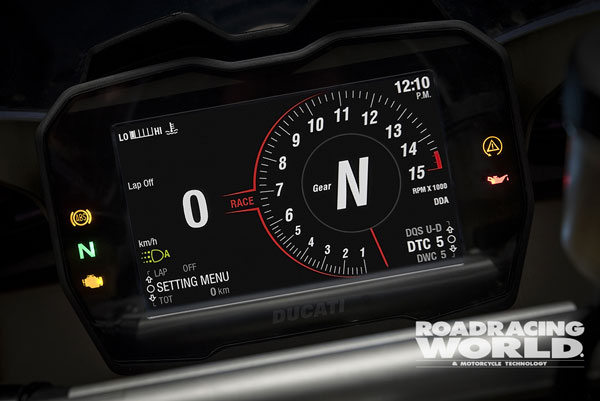
(Above) The Panigale V4 S TFT dash has what looks like an analog tach.
In terms of function, the
Ducati Traction Control (DTC), Ducati Wheelie Control (DWC), and Ducati Slide
Control (DSC) were solid. All three systems helped keep the Panigale V4 moving
forward through the acceleration zone without abruptly removing power. The DTC
would gently remove power from full lean to about three-quarters of the way
through the corner, then the slide control would take over, then the wheelie
control would come in as needed.
Ducati Slide Control is new
and makes you feel like a hero once you wrap your head around it. On most laps,
I’d get into
the DSC exiting Turn Six. The system allowed me to light up the rear tire and
drift out to the exit curb without letting off the throttle, the DTC and DSC
indicator lights on the dash lit up the whole time. But the slide control didn’t hold the bike back when
engaged; instead, it balanced the grip-to-slide ratio to keep the Ducati
Panigale V4 constantly driving forward.
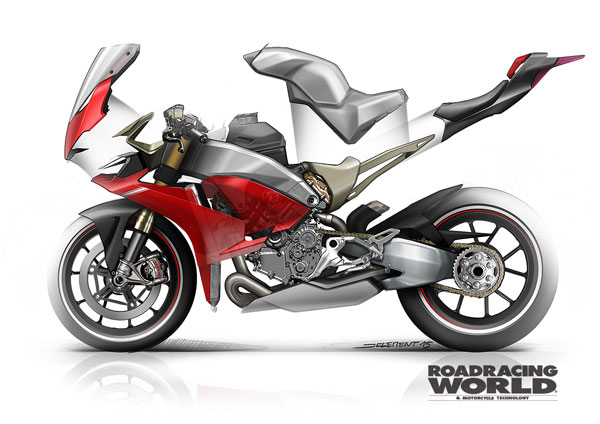
(Above) A diagram of how the tank fits over and behind the airbox and extends down and under the seat, to carry the weight of the fuel lower.
The Panigale V4 S chassis
was as impressive as the engine and electronics were. The new cast
aluminum-alloy frame with an attached magnesium subframe is stiffer and
provides a more direct feeling during turn-in and while transitioning the V4 S.
The frame had none of the twist, pump, twist experience common on the 1299
model. It was user-friendly from the start of the day until the end, whether I
was pushing or cruising around while playing with settings.
The fact is that I didn’t have to ask for many
changes to the chassis during the day, highlighting the improvements Ducati
engineers have made to the balance of the Panigale V4 S when compared to the
1299. It also responded as expected to suspension changes. The Öhlins Smart E.C. suspension
can be tuned for specific parts of a corner, with software dividing cornering
performance into three zones: Brake Support, Mid-Corner, and Acceleration. I
wanted more support on corner exits at Valencia, so I made an Acceleration zone
change (going from Level 2 to Level 4, which increased rear shock compression
damping) to give the Panigale V4 more
rear support. The change made the bike finish the corner better, but with
slightly less grip, which gave it more linear slide characteristics during
acceleration.
What was most impressive
was the fact that the change only affected the bike in the Acceleration
zone—the exit phase of the corner, from the end of the apex to the actual exit.
It was amazing to be able to change the bike’s behavior in a specific area of the corner,
without affecting any other section of the corner. The end result was a more
comfortable rider who turned faster lap times. Everything that happened made
sense.
I’ve
never been a big fan of ABS on motorcycles, but the new Bosch Cornering ABS EVO
system used on the Panigale V4 is really impressive. Set-up 1 is minimally
intrusive and allowed aggressive initial braking along with trail-braking down
to the apex without any apparent reduction of brake feel or power. The system
performed very well, allowing me to brake how I wanted, without intervening by
reducing braking power and causing the bike to run wide. The system also allows
the rider to slide the rear wheel and back in the bike when Set-up 2 is
selected. Frankly, backing the bike in is either specific to a rider’s style (and is usually a
slower way around the track) or a by-product of speed combined with poor clutch
or ECU set-up. And because I rarely use the rear brake, the ability to back it
into corners with the bike at 0-35 degrees off vertical did not really impress
me.
But staying on the subject
of electronic aids for braking, the Ducati Quick Shift (DQS) EVO worked and
Engine Brake Control (EBC) EVO helped keep the Panigale V4 S in line while
entering the corner. The duration and rev spike of the auto-blip function was
just right to provide smooth, clutchless downshifts without making the
transmission clunk into gear or pushing the bike into the corner. But I felt
the EBC had a little too much run-on, too early when braking hard for a corner,
even when set on Level 1, which is the maximum amount of engine braking
available. Once I had finished braking hard and was into the corner, the
lean-angle-dependent engine braking strategy provided the right amount of
engine brake to keep the wheels inline, dragging the bike down so I could
rotate it around the apex.
In an effort to find a
setting I was more comfortable with, I turned the EBC off completely for a few
laps during the session (I had to be stationary in the pit to turn it off). On
track, the Panigale was then better during hard braking, slowing down nicely,
but then there was too much engine braking once I got to the apex of the
corner—I had to crack the throttle early and get the engine going so I could
roll through the corner. In the end, I went back to EBC 1 and instead increased
my initial brake pressure.
To demonstrate the
performance of an uncorked Desmosedici Stradale V4 engine, Ducati sent
journalists out for one final session late in the day, aboard a modified Panigale
V4 S. The bike made 12 more horsepower than in standard trim, thanks to a
titanium Akrapovic racing exhaust system and revised engine mapping; had
revised DTC and DWC strategies; and was fitted with Pirelli Diablo Supercorsa
Pro slicks to handle the extra power. Ducati reps claimed the modified bike
made 226 horsepower at the crank and it only took one gear shift after my first
exit from pit lane to make me a believer! The modified Panigale V4 S pulled
harder than any of my Superbikes ever did and just kept going with no end to
the power. I’m
usually a less-is-more type of guy when it comes to electronics, but the
Panigale V4 S with the Akrapovic system made me regret my decision to turn down
the electronics before riding the bike! I tried to be conservative and waited
until the exit of Turn Six coming onto the back straight before I really
grabbed a handful of throttle. The front wheel was immediately off the ground
with the rear wheel lit up at the same time!
But the modified bike was
still a lot of fun to ride. Nothing brings out chassis problems like more
horsepower and grip, but the Panigale V4 was up to the challenge, and I found
myself cranking the V4 over and dragging my toes and boots more than usual
during my 15-minute final stint.
Ending the day ripping laps
on a hopped-up version of the Panigale V4 S drove home the fact that Ducati
motorcycles—at least since the first one I tested, the 998R—are all about
performance. And the company is willing to do what it needs to build the
best-performing, most-cutting-edge sportbike on the market, even if that means
abandoning the engine formula that it built its name on. I predict that the
Ducati Panigale V4 S not only marks the start of a new era for the brand, but
will also set the bar for ultra-performance sportbikes for years to come.
Tech Details
Motorcycles are becoming,
lighter, smaller, more compact, and more powerful than ever to gain an
incremental advantage on the competition. Small things count more than ever
these days, and what look like small details on paper can translate into big
lap time gains on the racetrack. The Panigale V4 is all about the details, from
the engine to chassis. The Panigale V4 S I tested in Valencia puts out a
claimed 214 horsepower at the crank and weighs in at 430 pounds (195 kg) wet,
which gives it a power-to-weight ratio of 1.10 horsepower per pound. The
Panigale V4 is oozing with real MotoGP technology, not just a fairing, but
rather real-deal hard parts including the engine configuration, bore diameter,
Desmodromic valve actuation, firing order, and the crown jewel of its enhanced
performance, a counter-rotating crankshaft.
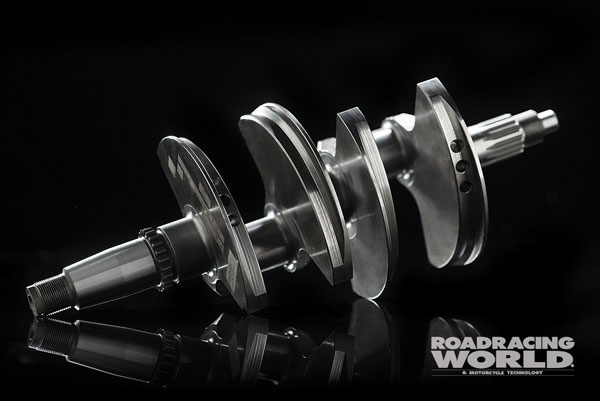
(Above) The Ducati Panigale V4 S crankpins are offset by 70 degrees to create what Ducati calls its “twin-pulse” uneven firing order, for better traction.
We’ll start with the
90-degree V-4, 16-valve Desmosedici Stradale engine. Ducati engineers leaned
heavily on the company’s MotoGP program for direction on the engine, and used the same bore, 81
mm—the maximum allowed by MotoGP rules. Because the first Panigale V4 was
going to be sold as a streetbike, the engineers increased the displacement from
MotoGP’s
maximum of 1000cc to 1103cc by using a longer, 53.5 mm stroke to maximize
torque output and create a nice, linear powerband. The compression ratio is a
very stout 14.1:1.
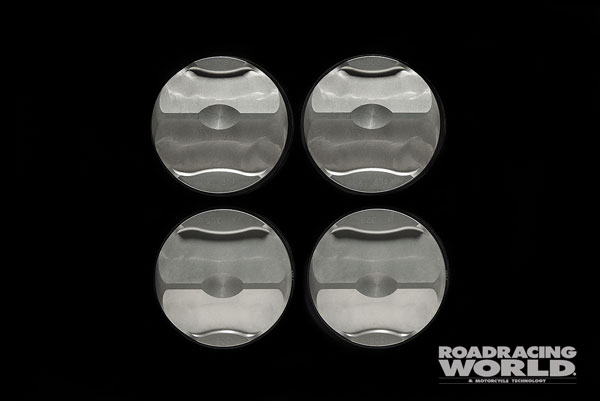
(Above) The Stradale engine’s 81 mm pistons are precisely shaped to produce a 14.1:1 compression ratio.
Probably the coolest and
most effective MotoGP feature is that counter-rotating crankshaft. Spinning the crank in the opposite direction
of the wheels helps negate some of the gyroscopic forces generated by the
wheels, which improves turning and makes it easier to change direction, and
also reduces pitch during braking and acceleration.
Ducati first implemented
the counter-rotating crankshaft on the 2015 Desmosedici MotoGP racebike, the
first MotoGP bike Gigi Dall’Inga was in charge of building after he left Aprilia and joined Ducati
in 2013. Reversing the crankshaft rotation helped fix some of the handling
problems Ducati riders had experienced with the Desmosedici up until then.
Reversing the rotation of
the crankshaft requires adding a jackshaft to allow the crank to spin backwards
while still propelling the bike forward via the transmission, countershaft, and
final drive. The jackshaft system adds weight and friction, which takes away
some horsepower, but the handling benefits are well worth the minor power
loss—and the V4 still has horsepower to spare.
As previously described,
the Desmosedici Stradale engine uses the same twin-pulse firing order as the
Desmosedici MotoGP racebike. This helps make the bike more tractable during
acceleration by allowing the rear tire
to recover traction between power pulses and gives the engine the power
characteristics of a V-Twin. To achieve the firing order they wanted in a
90-degree V-4, Ducati engineers offset the crank pins by 70 degrees.
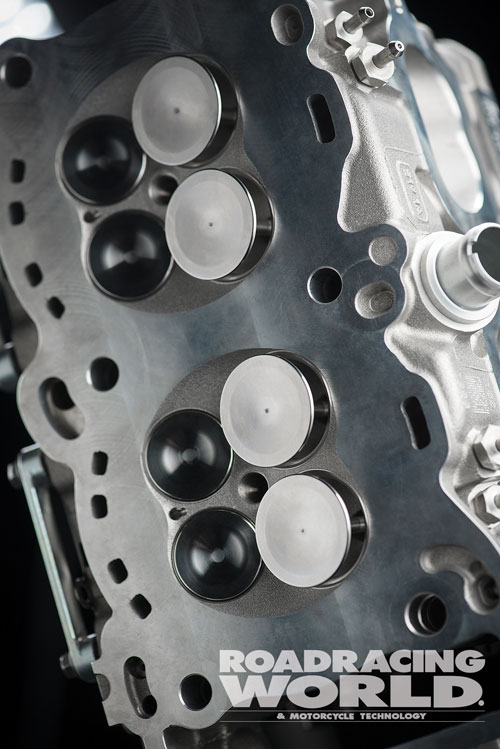
(Above) The engine has a 21.1 cc combustion chamber and four valves per cylinder.
The Panigale V4 also uses
Ducati’s
Desmodromic mechanical valve-opening and valve-closing system, which maintains
accurate valve actuation and control with high-lift cams and high peak rpm. The
34 mm intake valves and the 27.5 mm exhaust valves are steel, for durability.
The Stradale engine has a claimed redline of 14,500 rpm in first through fifth
gears, and adds another 500 rpm in sixth gear, taking the redline to 15,000
rpm—and an extra 500 rpm in top gear can be a life-saver (or position improver)
in race trim. Think of it as working like overdrive, while allowing the gear
ratios from first to fifth to be shorter without losing top speed in sixth
gear.
Feeding the engine is a
pair of double-barrel 52 mm ride-by-wire Mikuni throttle bodies fitted with
variable-length velocity stacks (a.k.a. air funnels) and eight fuel injection
nozzles, four located within the throttle bodies (one for each cylinder) and
four overhead shower injectors (one above each velocity stack). Each cylinder
bank has its own ride-by-wire motor, which allows them to be operated
independently, the best way to implement strategies ranging from traction
control to engine braking. The variable-length velocity stacks switch from long
to short depending on rpm (it feels like about 11,000 rpm) and throttle
position. Of course the basic idea is long stacks are better for lower rpm
power, while shorter stacks are better for top-end power.
The Stradale engine has a
semi-dry sump to reduce mechanical losses created by crankcase pressure. The
Ducati still has an oil pan, but it’s bolted to the bottom of the gearbox, not
underneath the crankshaft. Like the crankcases, the oil pan is made of magnesium,
and it is separated internally from the spinning crankshaft. The oiling system
uses four pumps: One delivers the oil; one scavenges oil from the cylinder head
and returns it to the sump; and the other two scavenge oil from the crankcase,
below the pistons, where pressure builds up. The system reduces internal
pressure and the drag caused by running the cams and the crankshaft through
accumulated (or pooled) oil. The Panigale V4 uses a six-speed transmission (as
mentioned earlier) and a hydraulically activated, assist-and-slip wet clutch
designed to increase plate pressure under acceleration (to reduce slip) and
decrease plate pressure under deceleration (to reduce back-torque and wheel hop
entering corners). The clutch has 22 plates, including 11 drive plates and 11
driven plates.
It’s all bundled together in a nice and compact,
but slightly heavy, V4. The engine configuration and dimensions have an
enormous role in the overall packaging of a bike, which also affects the way a
motorcycle handles. Ducati’s V-4 Desmosedici Stradale engine is 28 mm shorter vertically and 38 mm
shorter from front to back when compared to the latest version of the Panigale
V-Twin engine, but adding a cylinder to each side increased the width by 43 mm
compared to its V-Twin predecessor. The smaller dimensions allowed the V4
engine to be rotated backwards 42 degrees from the plane of the crankshaft,
placing it in what the engineers say is the same, optimal position as used for
the Desmosedici GP racebike. The V4 engine weighs 134 pounds (64.9 kg), making
it just 4.8-pounds (2.2 kg) heavier than the V-Twin Supersquadro engine despite
having more parts.
The V4 is all about
packaging, and Ducati engineers took full advantage of what was possible—which
means the chassis is a big departure from previous models that used a tubular
steel trellis chassis. The Panigale has an aluminum-alloy main frame, and it is
basically a short version of a conventional twin-spar, cast aluminum-alloy
perimeter spar frame, but is designed to work with the engine as a stressed
member, and the swingarm pivots in the crankcases. The main frame casting
incorporates a large headpiece and two sets of upper and lower spars, which
attach to each side of the engine. The main frame weighs 9.2 pounds (4.2 kg)
and gave Ducati engineers the ability to better tune the flex characteristics
of the chassis; the torsional (twist) rigidity and lateral (side to side)
rigidity of the frame can be tuned separately for the best balance between
stiffness and feel. The lower spars cradle the front cylinder, attaching to the
crankcases just below the cylinder, and the upper spar runs across the engine,
attaching to the rear cylinder bank using brackets. A magnesium subframe, which
weighs 4.2 pounds (1.9 kg), attaches to the top of the main frame and also
bolts to the rear cylinder bank at the bottom, forming a direct link from the
front to the rear of the bike.
Rake is 24.5 degrees, which
when combined with a triple clamp offset of 30 mm, produces 100 mm (4.2 inches)
of trail.
The 16-liter aluminum-alloy
fuel tank helps reduce weight while helping to centralize mass and minimize the
effect fuel sloshing has on handling. The tank is mounted above the upper frame
spars, runs down and behind the rear cylinder bank, and over the swingarm
pivot, with the base integrated into the seat above the rear shock. The shock
mount is also attached to the back of the engine, and the Öhlins EC 2.0 TTX 36 shock works through a
linkage with a 9.2% progression ratio.
Rotating the engine
rearward enabled engineers to move the swingarm pivot farther forward, allowing
the rear swingarm to be lengthened to 23.6 inches (600 mm)—which is hovering
around MotoGP length—without increasing the wheelbase. Using a longer swingarm
helps increase braking stability and rear grip, while also reducing the bike’s tendency to wheelie.
Swingarm angle is average, sitting around 11.67 degrees. The claimed wheelbase is 57.8 Inches (1,469
mm).
The Panigale V4 S model
comes standard with electronically controlled Öhlins suspension front and rear. At the front
is a set of 43mm NIX30 road and track forks with titanium nitride (TiN)
coating. Taking care of the rear is a TTX36 shock. The Öhlins Smart EC 2 system on the Panigale V4 S
has a new Objective Based Tuning interface (OBTi) which allows the system to
react to specific events. The Smart EC system uses input from the IMU along
with brake pressure, throttle position, and wheel speed to calculate where the
bike is in the corner, then adjusts the suspension accordingly. The system has
five levels of adjustment (1 being softest and 5 being hardest) for three
sections of the corner broken down into Brake Support, Mid-Corner, and
Acceleration.
The Panigale V4 comes with
Brembo 330 mm (12.9-inch) front brake discs and lightweight Brembo Stylema
monoblock calipers. Also standard are three-spoke Marchesini forged aluminum
wheels, and the Panigale V4 rolls on new generation Pirelli Diablo Supercorsa
SP tires. Pirelli engineers increased the width of the 120/70-ZR17 front tire
to produce a slightly larger contact patch. Rear tire width was increased by 16
mm, which made the rear contact patch 4.5 mm wider at full lean, on the
shoulder of the tire.
Ducati has upgraded the
electronics package on the Panigale V4 through a series of evolutions of
previously existing rider aids—which explains the EVO designation now used on
several. The upgraded rider aids are centered on a Bosch 6D (6-axis) Inertial
Measurement Unit (IMU), which detects roll, pitch, and yaw and sends the
information to the ECU to execute the necessary strategies to help keep the
bike under control and doing what the rider wants it to do. The use of an IMU
has become the standard for advanced motorcycle electronics these days, so it’s somewhat old news, but
the Bosch 6D IMU system processes the motorcycle’s movement very, very quickly,
improving the execution because it takes less time to detect the conditions
that create the need for electronic intervention.
The rider aids built into
the Panigale V4 S include ABS Cornering Bosch EVO (ABS EVO); Ducati Traction
Control EVO (DTC EVO); Ducati Slide Control (DSC); Ducati Wheelie Control EVO
(DWC EVO); Ducati Power Launch (DPL); Ducati Quick Shift up/down EVO (DQS EVO);
Engine Brake Control EVO (EBC EVO); and Ducati Electronic Suspension EVO (DES
EVO).
The Panigale V4 S features
three riding modes: Street, Sport, and Race. Full power is available in each
mode, but the rate of throttle opening is limited in the Street and Sport
modes. Street Mode has much softer throttle and suspension mapping, with the
rider aid levels turned up. Sport Mode has a more aggressive throttle map,
slightly stiffer suspension settings, less intrusive rider aid settings, and
allows the ABS value to be changed. Of course Race Mode is the most aggressive
of all, giving the rider direct throttle application, stiffer suspension, and
the ability to change all the settings.
It can be hard to keep up
with an ever-growing list of rider aids and functionality. But hitting the high
points, big changes were made to the ABS system on the Panigale V4. The EVO
system now has a three-level cornering ABS function aimed at improving
racetrack performance without sacrificing safety on the open roads. Level 3 is
for riding on the street, while Level 2 and Level 1 are designed for aggressive
riding on the racetrack. Level 2 has an interesting feature that allows the
rider to lock the rear brake and back the bike in at 0-35 degrees of lean. (I’d say the functional
racer in me looks at setting Level 2 as being unnecessary, but hey, it’s cool, have fun!) Level
1 is where the biggest advancements have been made, because the cornering
function allows the rider to brake aggressively without automatically reducing
brake pressure (and braking power) as the bike is leaned in. In other words, it
allows the rider to trail-brake to the apex of the corner, but if they overdo
it, it will react to help keep the rider from trail-braking themselves onto the
ground. It takes some of the danger out of trail-braking, although the system
can’t save a
rider who grabs a huge handful of brake lever and instantly spikes the brake
pressure!
DTC EVO offers nine levels
(1-8, plus Off) of traction control, with Level 1 producing the lowest and
Level 8 producing the highest level of intervention. As with previous models,
spin conditions are detected using input from the wheel speed sensors,
throttle, and IMU, with intervention being accomplished using either the
throttle plates to control power on corner exit, or by removing spark for an
unexpected big slide since the throttle plates react too slowly to catch that.
The strategy has been revised to limit big power cuts by recalculating the
allowable amount of grip in each setting. Ducati also gave the system a new “Spin on Demand” feature in DTC levels 1
and 2, which in theory should allow a less-experienced rider to use wheelspin
to finish the corner.
New on the Panigale V4 is
the two-level Ducati Slide Control (DSC). This system relies on the IMU’s ability to detect Yaw,
or when the bike goes sideways from sliding, and reacts to keep it from going
over the edge and highsiding the rider. Other measurements used to calculate
intervention requirements are acceleration (Pitch), lean angle (Roll), and
wheel speeds. The system limits wheel torque though a combination of reducing
throttle plate angle, cutting spark, and cutting fuel delivery as needed to
allow the rear tire to be hung out while still driving forward. Keeping the
Panigale moving forward, Ducati Wheelie Control EVO (DWC EVO) has been revised
to limit wheelies without removing too much power on acceleration. The EVO
system’s new
settings allow some wheel lift during corner exits, but doesn’t let it get out of
control or excessively slow acceleration.
Also new for 2018 is Ducati
Power Launch (DPL), or launch control. The system fitted on the Panigale V4
works in conjunction with the DWC and has three settings, with Level 3 being
least aggressive and Level 1 being the most aggressive. The system turns off at
about 100 mph or when the rider clicks into third gear. A clutch protection
feature was built into the system, which limits the number of consecutive
starts, to keep the clutch from getting burned up.
The revised strategies for
the Engine Brake Control EVO (EBC EVO) take engine braking to the next level on
a production bike. Ducati’s system adjusts pre-set engine braking parameters depending on the
situation, which is mainly based on rear tire wear. The system has four
settings (1-3, plus Off), with Level 1 producing the most engine braking, while
Level 3 has more run-on. Like most strategies, the engine braking is controlled
by throttle opening. Ducati’s Quick Shifter EVO up/down (DQS EVO) also works in conjunction with the
EBC system on downshifts, helping engage the desired gear by providing the
optimum amount of blip and duration via the ride-by-wire throttle control.
The DTC, DSC, DWC, and EBC
functions can be adjusted on the fly (while riding) through the left handlebar
switch bank. The functions that can’t be adjusted on the fly can be accessed using
the left handlebar to toggle through the new, 5-inch TFT dash display. The dash
has a choice of Track Layout, which displays lap time, and Street Layout, which
displays road information. Both modes have an analog-look tech display with
digital gear indicator and speed displays.
Ducati will also offer a
lower-spec Panigale V4, which comes fitted with Showa BPF (Big Piston Front)
forks and a Sachs rear shock along with a set of five-spoke cast aluminum-alloy
wheels and a U.S. MSRP of $21,195.
An ultra-premium, limited
production version, the Panigale V4 Speciale, will also be available, with
1,500 units being built. The Speciale boasts a claimed 226 bhp and weighs in at
414 pounds (188 kg). It comes fitted with a titanium Akrapovic exhaust, revised
rider aid and throttle maps, a host of special carbon-fiber parts, and a
special tri-color paint scheme with a MSRP of $39,995.
The Panigale V4 S as tested
in Valencia for this article will come with a MSRP of $27,496 and should be
available before spring.
Editorial Note: This article was originally published in the March 2018 print issue of Roadracing World & Motorcycle Technology.
